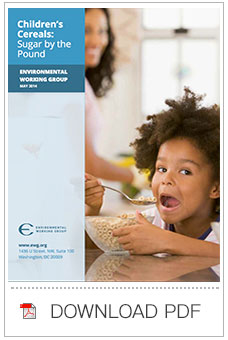 A comprehensive analysis by the Environmental Working Group of 1,556 cereals, including 181 marketed for children, shows that most pack in so much sugar that someone eating an average serving of a typical children’s cereal would consume more than 10 pounds of sugar a year from that source alone. And even though researchers have found that children are happy to eat low-sugar cereals, the supermarket cereal aisle offers few such products – and children’s cereals with cartoon characters on the box are among the most highly sweetened of all. EWG also re-reviewed a smaller sample of 84 popular children’s cereals that it had previously evaluated in 2011. This analysis found that while a handful of manufacturers lowered the sugar content of 11 cereals in that sample, the vast majority are still too sweet to be healthy, averaging two teaspoons per serving. One cereal added even more sugar. Not one of the 10 most sweetened cereals on EWG’s 2011 list lowered its sugar content.
A comprehensive analysis by the Environmental Working Group of 1,556 cereals, including 181 marketed for children, shows that most pack in so much sugar that someone eating an average serving of a typical children’s cereal would consume more than 10 pounds of sugar a year from that source alone. And even though researchers have found that children are happy to eat low-sugar cereals, the supermarket cereal aisle offers few such products – and children’s cereals with cartoon characters on the box are among the most highly sweetened of all. EWG also re-reviewed a smaller sample of 84 popular children’s cereals that it had previously evaluated in 2011. This analysis found that while a handful of manufacturers lowered the sugar content of 11 cereals in that sample, the vast majority are still too sweet to be healthy, averaging two teaspoons per serving. One cereal added even more sugar. Not one of the 10 most sweetened cereals on EWG’s 2011 list lowered its sugar content.
Cereals can provide important nutrients that children need during critical times of growth and development – without all the added sugar. Unsweetened whole-grain hot cereals such as oatmeal with fruit on top are a much healthier choice, providing a rich source of naturally occurring vitamins and minerals and no empty calories. The reality, however, is that hot cereals can be less convenient for busy families – although there are many ways to work around this – making the lack of low-sugar cold cereals all the more problematic.
EWG’s analysis shows that of all cereals, those that have cartoon characters on the box indicating they are marketed directly to children are the most heavily loaded with added sugar, making them a significant source of empty calories. A typical serving can contain as much sugar as three Chips Ahoy! or two Keebler Fudge Stripe cookies. EWG found that on average, 34 percent of the calories in children’s cereals come from sugar. For two-thirds of these cereals, a single serving contains more than a third of what experts recommend children consume in an entire day. For 40 cereals, a single serving exceeds 60 percent of the daily amount of sugar suggested by health agencies and organizations. Some contain as many as six different types of sweeteners.
Although the cereal aisle in a typical supermarket looks as if it’s full of choices, EWG found that there are very few low-sugar options – especially among cereals marketed for children. Of the 181 that EWG examined, not one was free of added sugars. EWG also found evidence that promotional labeling on cereal boxes is designed to distract consumers from focusing on the unhealthy sugar content by making claims that the product provides important nutrients, such as “Excellent Source of Vitamin D” or “Good Source of Fiber.” The labels on seven of the 10 most heavily sugared children’s cereals in EWG’s 2011 cereal report currently feature a marketing claim promoting their nutrient content.
The Food and Drug Administration has not yet set a limit on the amount of added sugars allowed in products that make nutritional claims, nor does the agency include a percent Daily Value for sugar on the Nutrition Facts panel required on food products to help inform consumers how much sugar is too much. For saturated fat, it does both.
In contrast, the Department of Health and Human Services and the Department of Agriculture provided authoritative guidance in the 2010 Dietary Guidelines for Americans, recommending that solid fats and added sugar together should constitute no more than about 5-to-15 percent of total calorie intake (USDA and DHHS 2010). Currently, Americans consume 22 teaspoons of sugar a day on average, which amounts to 16 percent of total calorie intake from added sugars alone (NCI 2010; USDA and DHHS 2010). The World Health Organization, the leading international authority on public health, has said since 2003 that sugars should make up less than 10 percent of total energy intake (WHO 2003).
Earlier this year (March 2014), the FDA proposed listing added sugar content in the Nutrition Facts panel (FDA 2014a). This would be a step in the right direction, bringing the required labeling in line with the US Dietary Guidelines and providing consumers with the information they need to reduce sugar consumption. However, the proposed regulations do not update the serving sizes for cereals (FDA 2014b). FDA’s own data show that the average American eats 30 percent more than the amount used to set the labeled serving sizes for the most popular category of cold cereals. This means that on average, people consume even more sugar than the labels would indicate (FDA 2014b).
Cereals are not the only source of added sugar in the American diet, of course. Sugars are added everywhere – from beverages to bread, tomato sauce and salad dressings – contributing to growing waistlines, decayed teeth and a multitude of obesityrelated diseases. The USDA itself calls sugar “the number one food additive” (USDA 2003).
Source: http://www.ewg.org/research/childrens-cereals-sugar-pound/executive-summary
http://static.ewg.org/reports/2014/cereals/pdf/2014-EWG-Cereals-Report.pdf

Sem comentários:
Enviar um comentário
Qualquer mensagem inapropriada não será considerada.